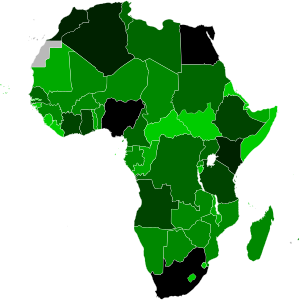List of African countries by GDP (nominal)
Gross domestic product (GDP) is the market value of all final goods and services from a nation in a given year. Countries in Africa are sorted according to data from the International Monetary Fund. The figures presented here do not take into account differences in the cost of living in different countries, and the results can vary greatly from one year to another based on fluctuations in the exchange rates of the country's currency.[1] Such fluctuations may change a country's ranking from one year to the next, even though they often make little or no difference to the standard of living of its population.[2]
Some countries may have citizens that are on average wealthy. These countries/regions could appear in this list as having a small GDP. This would be because the country/region listed has a small population, and therefore small total economy; the GDP is calculated as the population times market value of the goods and services produced per person in the country.[3][4]
These figures should therefore be used with caution.
Comparisons of national wealth are also frequently made on the basis of purchasing power parity (PPP), to adjust for differences in the cost of living in different countries. PPP largely removes the exchange rate problem, but has its own drawbacks; it does not reflect the value of economic output in international trade, and it also requires more estimation than nominal GDP.[5] On the whole, PPP per capita figures are more narrowly spread than nominal GDP per capita figures.[6]
The 2022 estimates are as follows:[7]
| Rank | Country | Nominal GDP (Billion US$)[8][9] |
Per Capita (US$)[8][9] |
|---|---|---|---|
| 1 | 504.203 | 2,326.230 | |
| 2 | 469.094 | 4,504.369 | |
| 3 | 411.480 | 6,738.926 | |
| 4 | 187.155 | 4,151.437 | |
| 5 | 142.874 | 3,896.214 | |
| 6 | 124.794 | 3,790.704 | |
| 7 | 114.858 | 2,255.480 | |
| 8 | 111.181 | 1,097.584 | |
| 9 | 76.582 | 1,245.040 | |
| 10 | 75.996 | 2,368.814 | |
| 11 | 68.630 | 2,418.436 | |
| 12 | 63.909 | 660.210 | |
| 13 | 48.352 | 1,105.590 | |
| 14 | 46.282 | 3,815.820 | |
| 15 | 44.212 | 1,584.003 | |
| 16 | 42.762 | 916.033 | |
| 17 | 40.836 | 6,025.680 | |
| 18 | 38.280 | 2,420.220 | |
| 19 | 27.542 | 1,558.144 | |
| 20 | 27.025 | 1,348.360 | |
| 21 | 22.221 | 10,281.775 | |
| 22 | 19.745 | 1,345.568 | |
| 23 | 18.434 | 857.976 | |
| 24 | 18.268 | 824.884 | |
| 25 | 18.005 | 7,347.738 | |
| 26 | 17.873 | 542.095 | |
| 27 | 17.547 | 1,366.871 | |
| 28 | 16.877 | 11,264.416 | |
| 29 | 15.106 | 521.578 | |
| 30 | 14.639 | 561.222 | |
| 31 | 14.486 | 2,945.102 | |
| 32 | 12.945 | 743.373 | |
| 33 | 12.488 | 4,808.922 | |
| 34 | 12.098 | 912.744 | |
| 35 | 11.554 | 522.963 | |
| 36 | 11.497 | 9,111.606 | |
| 37 | 10.091 | 2,328.251 | |
| 38 | 8.416 | 539.001 | |
| 39 | 8.359 | 960.833 | |
| 40 | 4.784 | 327.898 | |
| 41 | 4.669 | 4,056.177 | |
| 42 | 4.101 | 493.572 | |
| 43 | 3.900 | 735.185 | |
| 44 | 3.725 | 3,665.827 | |
| 45 | 3.686 | 292.619 | |
| 46 | 2.507 | 1,186.744 | |
| 47 | 2.488 | 495.936 | |
| 48 | 2.369 | 646.957 | |
| 49 | 2.172 | 846.171 | |
| 50 | 2.053 | 3,600.223 | |
| 51 | 2.005 | 20,265.681 | |
| 52 | 1.624 | 856.620 | |
| 53 | 1.242 | 1,299.682 | |
| 54 | 0.506 | 2,230.662 | |
| -- | Total | 2,988.527 | 2,175.195 |
See also
- List of African countries by GDP (PPP)
- List of African countries by Human Development Index
- Economy of Africa
References
- ^ Moffatt, Mike. "A Beginner's Guide to Purchasing Power Parity Theory". About.com. IAC/InterActiveCorp. Retrieved 31 May 2014.
- ^ Ito, Takatoshi; et al. (January 1999). "Economic Growth and Real Exchange Rate: An Overview of the Balassa-Samuelson Hypothesis in Asia" (PDF). Changes Rates in Rapidly Development Countries: Theory, Practice, and Policy Issues. National Bureau of Economic Research. Retrieved 1 June 2014.
- ^ "What is GDP and why is it so important?". Investopedia. IAC/InterActiveCorp. 26 February 2009. Retrieved 30 May 2014.
- ^ "GDP rankings in Africa". visafrican. Visafrican.com. 23 July 2016. Retrieved 23 July 2016.
- ^ Callen, Tim (28 March 2012). "Purchasing Power Parity: Weights Matter". Finance & Development. International Monetary Fund. Retrieved 30 May 2014.
- ^ Callen, Tim (28 March 2012). "Gross Domestic Product: An Economy's All". Finance & Development. International Monetary Fund. Retrieved 31 May 2014.
- ^ "Report for Selected Countries and Subjects". IMF.
- ^ a b "World Economic Outlook database SSA: April 2022 Nominal GDP". imf.org.
- ^ a b "World Economic Outlook database NA: April 2022 Nominal GDP". imf.org.

